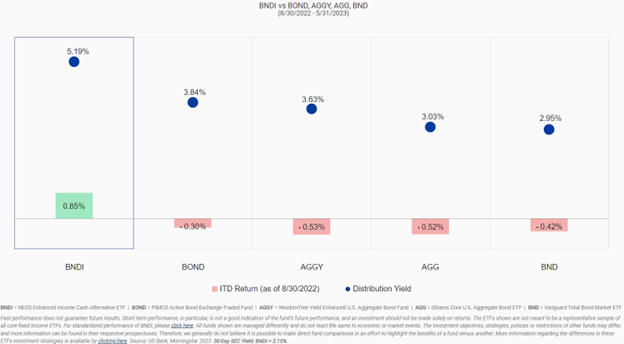The last year felt much like a renaissance for bond ETFs, with a bevy of new and innovative strategies coming to market. One such fund, the NEOS Enhanced Income Aggregate Bond ETF (BNDI), launched at the end of August and has generated consistently noteworthy total returns and dividend yields since launch within core bond allocations.
Advisors and investors looking to optimize or enhance their bond allocations would do well to consider BNDI. Since inception, the fund generated total returns of 0.85% through 05/31/23. It outperformed the broad bond market as measured by the Vanguard Total Bond Market ETF (BND), the iShares Core U.S. Aggregate Bond ETF (AGG), and other core bond ETFs.

Image source: NEOS
What’s more, the fund continues to generate noteworthy distribution yields. BNDI’s distribution yields are 5.19% as of 05/31/23, significantly above broad bond ETFs.
BNDI is an actively managed ETF that seeks to offer enhanced monthly income distributions for investors. The fund invests across the broad U.S. Aggregate Bond Market while also implementing a tax-efficient options strategy that generates additional income.
See also: “Don’t Miss Portfolio Yield Potential With NEOS Income ETFs“
Enhance Bond Yields and Returns With BNDI
The fund invests in the Vanguard Total Bond Market ETF (BND) and the iShares Core U.S. Aggregate Bond ETF (AGG). The income and capital gains that BNDI receives from its bond allocations are enhanced by the addition of monthly income from the fund’s put-option strategy on the S&P 500. The strategy entails selling short puts and buying long puts to protect against volatility.
The strategy may offer positive returns in both flat and rising equity markets. It may also generate positive returns in moderately-declining equity markets. This is possible if the premium from the puts bought and sold is greater than the cost to close out the positions. BNDI may also offer a lower correlation to certain risk factors such as duration, credit, and inflation risk.
BNDI’s put options aren’t ETF options but S&P 500 index options. These options are taxed favorably as Section 1256 Contracts under IRS rules. The IRS treats options held at the end of the year as if the investor had sold on the last market day of the year at fair market value. Most importantly, the IRS taxes any capital gains as 60% long-term and 40% short-term, no matter how long the fund held them.
This treatment can offer noteworthy tax advantages. In addition, the fund’s managers also may engage in tax-loss harvesting opportunities throughout the year on the put options.
BNDI currently has an expense ratio of 0.58%.
For more news, information, and analysis, visit the Tax-Efficient Income Channel.

